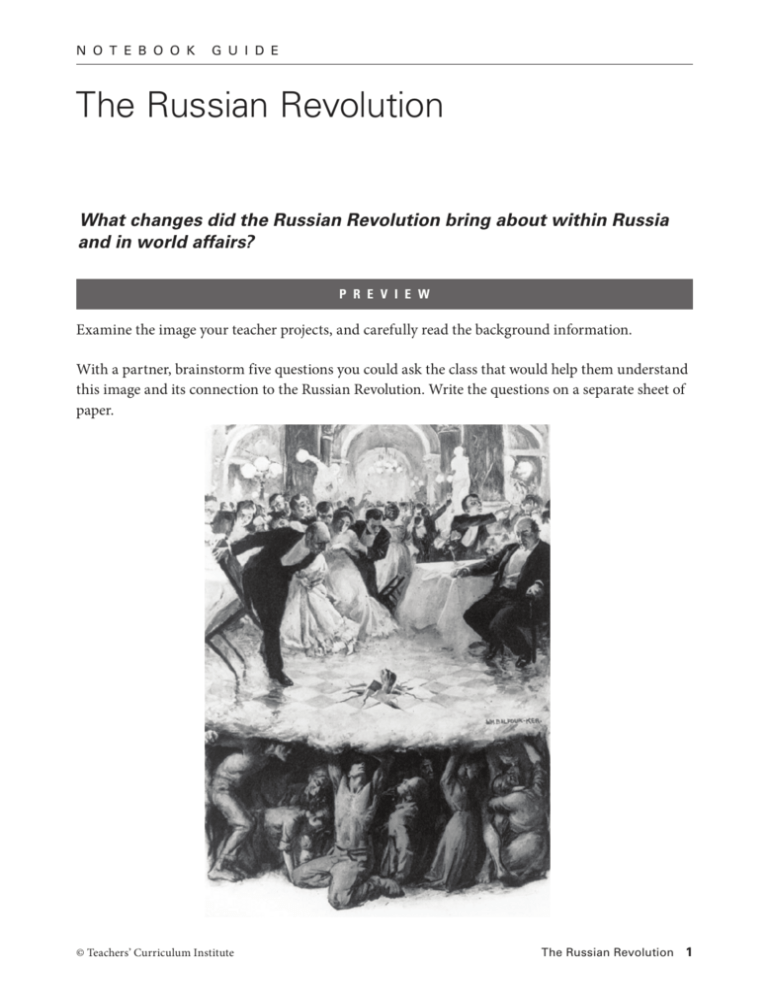The Russian Revolution
advertisement

N O T E B O O K G U I D E The Russian Revolution What changes did the Russian Revolution bring about within Russia and in world affairs? P R E V I E W Examine the image your teacher projects, and carefully read the background information. With a partner, brainstorm five questions you could ask the class that would help them understand this image and its connection to the Russian Revolution. Write the questions on a separate sheet of paper. © Teachers’ Curriculum Institute The Russian Revolution 1 N O T E B O O K G U I D E R E A D I N G N O T E S Key Content Terms As you complete the Reading Notes, use these terms in your answers. entrepreneur socialism underground civil liberties Section 2 “Russia Under the Czars” and “The Beginnings of Unrest” 1. How were Russian czars different from most other rulers in Europe at this time? 2. What was life like for peasants and the middle class in Russia around 1900? 3. Why did Czar Alexander II decide to liberate the serfs? 4. How did peasants and nobles feel about emancipation? “Revolutionary Movements” and “The Last Czars” 1. What reforms did Alexander II attempt and what was the result? 2. What different types of revolutionary movements existed in Russia in the late 1800s? 3. After Alexander II was assassinated in 1881, who succeeded him and what did he do? 4. Who was Nicholas II and what problems did he face? Section 3 “Moving Toward Revolution,” “The Rise of Political Parties,” and “Marxism and Leninism” 1. What was life like for industrial workers in Russia in 1900? 2. Describe the theory of Marxism. 3. What did Marx believe would be the final state of revolution? 4. How did Lenin’s views differ from Marx’s? What was the name of Lenin’s political party? “The Revolution of 1905” and “Reform, Repression, and Continued Unrest” 1. What caused the 1905 Revolution? 2. What were soviets and what did they do? 3. What reforms did Nicholas II agree to and were they successful? 4. How did Nicholas II attempt to keep control of Russia? © Teachers’ Curriculum Institute The Russian Revolution 2 N O T E B O O K G U I D E Section 4 “The Bolsheviks Take Control,” “The February Revolution,” and “Dual Power” 1. How did Russians feel about the Great War? 2. Where did the 1917 February Revolution begin and how did it spread? 3. How did Nicholas II react to the February Revolution? What actions did the Duma take? 4. What was the “dual power” system that now tried to rule Russia and was it successful? “The October Revolution” 1. Why was Lenin not successful in overthrowing the Provisional Government in April 1917? 2. What factors allowed the Bolsheviks to increase power in Russia? 3. How was the Provisional Government overthrown on October 25, 1917? 4. What actions were then taken by the Congress of Soviets? “Civil War” 1. After the October Revolution, what actions were taken by the Bolsheviks to try to keep control? 2. What happened to the first elected national assembly in Russia and why? 3. What were the two sides called in the Civil War? Which side did the United States support? 4. Who won the civil war? What was the name of the new country? “War Communism and the Red Terror” and “New Policies and New Leadership” 1. What was war communism and how did the peasants react to it? 2. Describe the Red Terror. 3. What changes did the New Economic Policy institute? 4. Do you think Lenin’s communist revolution was successful? Why or why not? P R O C E S S I N G Create a three-panel cartoon strip showing what life was like in Russia before, during, and after the Russian Revolution of 1917. Each panel should include a simple illustration depicting the time period and a caption, thought bubbles, or speech bubbles. Use the following terms somewhere in your cartoon strip: civil liberties, Communist, revolution, Red Terror. © Teachers’ Curriculum Institute The Russian Revolution 3






